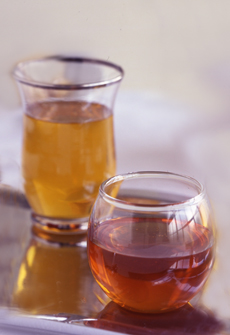
Straight or spiked, spiced apple cider is a hot. Photo courtesy National Honey Board.
November 2010 |
 |
Spiced Cider
Serve Spiced Apple Cider Straight Or With A Kick Of Rum
CAPSULE REPORT: A chill in the air means it’s time for a warm cocktail. Spiced cider—which can be served with or without alcohol—is a cold weather favorite. Here’s a delicious recipe. Click on the black link below for more recipes.
Spiced Cider Recipe
This recipe can be made plain, with optional rum added for guests who want it. Serves 6 to 8, depending on size of vessel.
Ingredients Per Cocktail
- 2 quarts apple cider (we get ours at the farmers market)
- A few grinds of fresh nutmeg
- A slice of fresh ginger or a pinch of powdered ginger
- 1 cinnamon stick
- 2 large apples (1 is for optional garnish—we use Honeycrisp,
our favorite variety)
- 1 tablespoon whole cloves
NOTE: If your cloves are more than 3 years old, replace them. If the old cloves have any scent left, you can simmer them in a pan of hot water alone or with citrus peel to create a holiday scent in the air.
- 1-½ cups of rum
NOTE: Spiced rum is perfect here, or use
light rum rather than dark rum if you have it. You can substitute another spirit if you don’t have rum; a darker-colored spirit creates a darker colored drink, as shown in the photo above.
- Garnish: 8 apple wedges or lemon wheels (you can stick a few whole cloves into either; cut apple wedges right before serving or brush with lemon juice to prevent browning)
*You can put the apple in the fridge; then slice it and sprinkle with cinnamon as a snack. Or, core the apple, place in a shallow dish with a half-inch of water and a teaspoon of your favorite sweetener (sugar, Splenda, honey). Then sprinkle the cored center with cinnamon and microwave the apple for 60 seconds. The cinnamon and sugar in the water will create a light sauce. Enjoy your baked apple hot or cold.
Preparation
- In a pasta pot or other large pot, bring apple cider, nutmeg and ginger to a simmer.
- Stud the apple with whole cloves (like a pomander) and add to the pot.
- Simmer for an additional 10 minutes and remove from heat.
- Remove apple and reserve for other use.*
- Add rum to pot and stir to blend. To provide a non-alcoholic option, withhold rum from pot add it by the shot for those who want it (add rum into individual cider-filled mug and stir).
- Pour into glass mugs, teacups or other drinkware with a handle; garnish with apple or lemon and serve.
|
|

If you don’t have glass mugs, they’re lovely for mulled drinks, tea, Irish coffee, even soup. These glass mugs are very affordable. |
Reduced Calorie Version
Use Tropicana’s Trop 50 Apple Drink instead of apple cider. It has half the calories and sugar.
If you like this recipe, check out Mulled Wine, Glögg, Toddy and other warm, spiced drinks.
Apple Cider History
Apple trees were growing in the Nile River Delta as early as 1300 B.C.E. There aren’t any hieroglyphs showing the pressing of apples into cider. But fast forward 1300 centuries, to the Roman legion arriving in what is now Kent, England in 55 B.C.E. They found villagers drinking a cider-type fermented beverage made from apples. No one knew how long they’d been making it, but it was a welcome discovery. Julius Caesar, who first visited Kent (then called Cantium) in 55 B.C.E., is known to have been a cider fan (what’s not to like?).
By the beginning of the 9th century, much of Europe was drinking alcoholic cider (simply called cider). By the 11th century, orchards were specifically growing cider apples—varieties that produced the most and best juice. And early English settlers brought these apple seeds to the New World. Cider became the drink of the day. Drinking a spiced alcoholic beverage can be traced back at least to the Middle Ages (mead, mulled beer and wine and wassail, for example).
The 19th-century German immigration to the U.S. led to the building of breweries that made beer—a much faster fermentation than cider, with much more production capacity than the average apple orchard (the production of apple cider took place on small farms). The religiously based Temperance movement then caused many church-going farmers to give up cider. Some even went as far as to chop down their apple trees. Then Prohibition became the law and pretty much destroyed the market for apple cider.
.
Recipe© copyright Bacardi USA. All rights reserved. Other material
Lifestyle Direct, Inc. All rights reserved. Images are the copyright of their individual owners.

|



